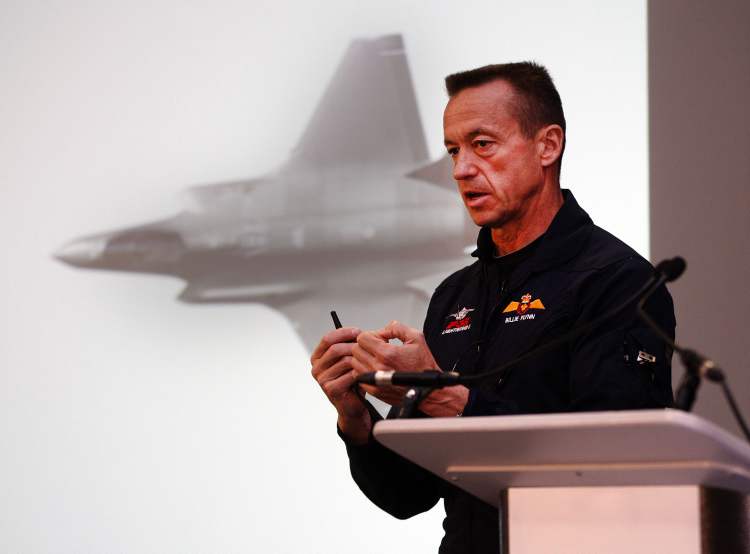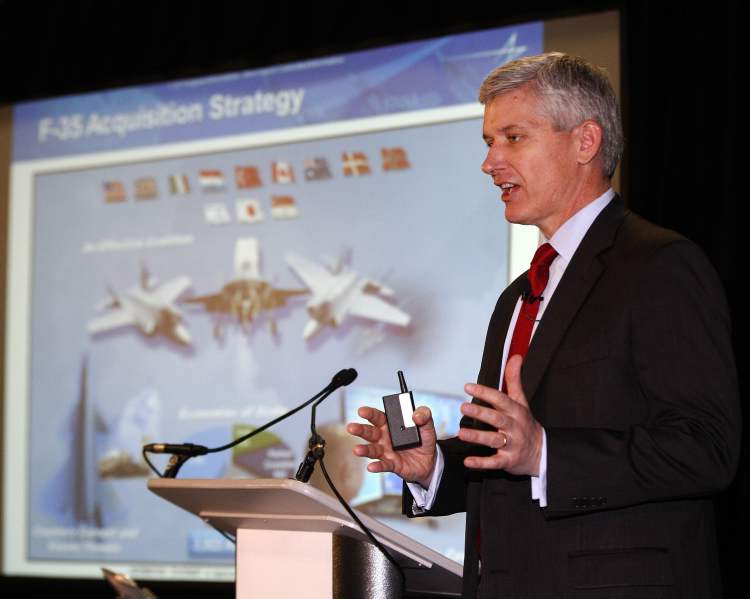Lockheed visits to boost F-35
Advertisement
Read this article for free:
or
Already have an account? Log in here »
To continue reading, please subscribe:
Monthly Digital Subscription
$0 for the first 4 weeks*
- Enjoy unlimited reading on winnipegfreepress.com
- Read the E-Edition, our digital replica newspaper
- Access News Break, our award-winning app
- Play interactive puzzles
*No charge for 4 weeks then price increases to the regular rate of $19.00 plus GST every four weeks. Offer available to new and qualified returning subscribers only. Cancel any time.
Monthly Digital Subscription
$4.75/week*
- Enjoy unlimited reading on winnipegfreepress.com
- Read the E-Edition, our digital replica newspaper
- Access News Break, our award-winning app
- Play interactive puzzles
*Billed as $19 plus GST every four weeks. Cancel any time.
To continue reading, please subscribe:
Add Free Press access to your Brandon Sun subscription for only an additional
$1 for the first 4 weeks*
*Your next subscription payment will increase by $1.00 and you will be charged $16.99 plus GST for four weeks. After four weeks, your payment will increase to $23.99 plus GST every four weeks.
Read unlimited articles for free today:
or
Already have an account? Log in here »
Hey there, time traveller!
This article was published 13/04/2013 (4619 days ago), so information in it may no longer be current.
Lockheed Martin officials insist the cost of the controversial F-35 Lightning fighter jet is coming down and the price for Canadian deliveries in 2020 would be about $75 million per plane.
Steve O’Bryan, a company vice-president, said that’s down from $250 million per plane the first ones cost.
Officials from Lockheed Martin, the prime contractor for the F-35 program, stopped in Winnipeg Friday on a tour of the country to promote the controversial military aircraft as part of its efforts to persuade Canada to buy 65 of the fifth-generation stealth fighters.

“We are confident where we are with the program. We are hitting all the milestones,” O’Bryan said, noting the latest U.S. budget fully funds the program and U.S. Secretary of Defence Chuck Hagel recently gave it the thumbs-up.
The Winnipeg presentation was held inside the 138,000-square-foot building Bristol Aerospace built specifically to handle production of the horizontal tail assemblies and more than 100 other parts for the F-35.
Bristol general manager Don Boitson said his company is doing the largest volume of work on the F-35 in Canada. He said it has the potential for more than $2 billion in revenue through the life of the program to the year 2030 and to provide a generation’s worth of work for up to 300 people.
“By the end of this year, we will have shipped $100 million worth of parts,” Boitson said. “This shows how far along the program is.”
Canada was part of the original coalition of eight countries plus the U.S. that decided to develop the jet more than 10 years ago.
Because of serious concerns about cost overruns, a suspect process by which the decision was made to buy the jets and questions about the plane’s operational excellence, the Canadian government has established a review process before it signs a contract to buy the planes.
As part of that process, Lockheed Martin must give Ottawa a status report on a seven-point plan by mid-May.
O’Bryan and a bevy of company officials, including Billie Flynn, an F-35 test pilot and former Royal Canadian Air Force CF-18 pilot, did their best to show how confident the company is that the cost and competitive issues had all been put to rest.
“This plane will be transformational,” Flynn said.
In particular, Flynn said the plane’s sensor capabilities in the coming new era of Arctic surveillance will be crucial for Canadian Arctic sovereignty.
But irrespective of the plane’s relative operational excellence, the development program has already had a significant impact on a company such as Bristol, a division of Mississauga-based Magellan Aerospace.
Bristol has invested more than $60 million and will spend another $40 million if the contracts keep rolling in.
It has 100 workers dedicated to the F-35 program and Boitson said the company will need 200 more as production continues to accelerate.
An indication of the economic impact of the work is that the provincial and federal governments have made up to $60 million in loans available to Bristol so it could get into the F-35 program.
Boitson said only companies from partner nations were eligible to bid on production work. He said the company has acquired new laser inspection equipment and precision milling machines of a kind that does not exist outside the United States.

“We have taken our technological capabilities to new levels for this aircraft, but also for future business and future aircraft platforms that we can work on,” he said.
He refused to speculate on the impact on his company’s operations if the Canadian government decides not to purchase the F-35.
“This is the largest military procurement program in history,” Boitson said. “For us to be involved in something of this magnitude is unprecedented.
“It is huge and will be significant if a decision is made not to proceed.”
martin.cash@freepress.mb.ca
Who’s signed on and who hasn’t
— Canada, Denmark and Turkey are the only countries from the original coalition to not yet commit to purchasing the F-35.
— The U.K., Netherlands, Italy, Australia and Norway have planes on order and the U.K. has already received its first two.
— Israel and Japan have also ordered the plane, and South Korea and Singapore are both in the process of considering it.
— The U.S. now has more than 60 of the planes deployed at six bases.
— Bristol Aerospace in Winnipeg is making the horizontal tail assemblies for one of three versions of the jet, the LiftFan vane box assemblies for another model, and 100 smaller titanium, aluminum and composite parts.

